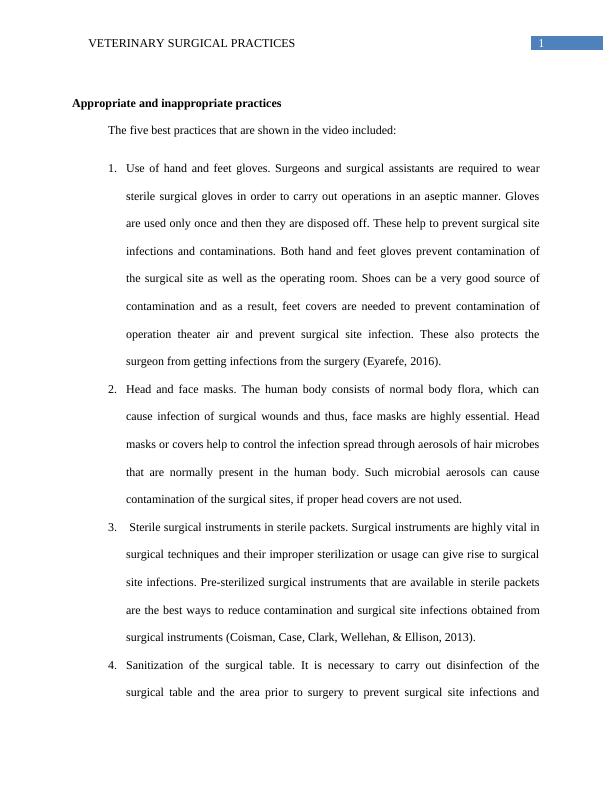Veterinary Surgical Practices Assignment
Added on 2020-04-21
8 Pages1809 Words85 Views
Running head: VETERINARY SURGICAL PRACTICESVETERINARY SURGICAL PRACTICESName of the StudentName of the UniversityAuthor Note

1VETERINARY SURGICAL PRACTICESAppropriate and inappropriate practicesThe five best practices that are shown in the video included: 1.Use of hand and feet gloves. Surgeons and surgical assistants are required to wearsterile surgical gloves in order to carry out operations in an aseptic manner. Glovesare used only once and then they are disposed off. These help to prevent surgical siteinfections and contaminations. Both hand and feet gloves prevent contamination ofthe surgical site as well as the operating room. Shoes can be a very good source ofcontamination and as a result, feet covers are needed to prevent contamination ofoperation theater air and prevent surgical site infection. These also protects thesurgeon from getting infections from the surgery (Eyarefe, 2016).2.Head and face masks. The human body consists of normal body flora, which cancause infection of surgical wounds and thus, face masks are highly essential. Headmasks or covers help to control the infection spread through aerosols of hair microbesthat are normally present in the human body. Such microbial aerosols can causecontamination of the surgical sites, if proper head covers are not used. 3. Sterile surgical instruments in sterile packets. Surgical instruments are highly vital insurgical techniques and their improper sterilization or usage can give rise to surgicalsite infections. Pre-sterilized surgical instruments that are available in sterile packetsare the best ways to reduce contamination and surgical site infections obtained fromsurgical instruments (Coisman, Case, Clark, Wellehan, & Ellison, 2013). 4.Sanitization of the surgical table. It is necessary to carry out disinfection of thesurgical table and the area prior to surgery to prevent surgical site infections and

2VETERINARY SURGICAL PRACTICEScontaminations. It also helps to prevent the spread of multi-drug resistant bacteria.Common disinfectants include phenols, aldehydes like formaldehyde, alcohols likeisopropyl alcohol. Anti-microbial detergents or soaps can also be used (Addie et al.,2015). 5.Autoclaving of the surgical instruments after surgery. Surgical instruments areusually sterilized by moist heat using autoclaving techniques. It is necessary tosterilize surgical instruments after surgery to prevent spread of wound infections fromone surgery to another. The recommended autoclaving temperature is 250ºF for 13-15minutes and an additional 2-5 minutes for extra safety precautions. Autoclaving helpstop kill the microorganisms that are present in the surgical instruments after thesurgical procedure (Dancer, Stewart, Coulombe, Gregori & Virdi, 2012). The ten inappropriate practices that are shown in the video included: 1.The VOA surgical assistant nor the surgeon was shown to wash hands prior towearing gloves. Gloves do not completely reduce the chances of contamination andtherefore it is necessary to wash and disinfect the hands prior to wearing surgicalgloves. Gloves can tear during surgeries and as a result, clean hands can preventbacterial transmission from the surgeon to the patient. 2.The VOA surgical assistant placed the gloves, which would be used to cover herhands and feet on the table, which was not disinfected. This can cause infections insurgical sites and can result in the spread of pathogenic microorganisms.3.During the surgery, the VOA surgical assistant did not wear gloves in her hands. Sheused her uncovered hands to open the surgical wrap and touch other surgical

End of preview
Want to access all the pages? Upload your documents or become a member.
Related Documents
Veterinary Clinical Skills Assignmentlg...
|8
|1682
|95
Preventing Cross Infection in Dental Settingslg...
|16
|4316
|388
Nursing Assignment: Aseptic Techniques in Drain Tube Removallg...
|7
|1553
|7
Instruments and Equipment used for Clinical Dental Care : Assignmentlg...
|12
|3588
|146
Infection Control Manual Sample Assignmentlg...
|5
|707
|42
NMBA Registered Nurses Standards for Practice: 5lg...
|1
|792
|84
